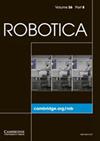移动机器人覆盖路径规划的多目标优化方法
IF 2.7
4区 计算机科学
Q3 ROBOTICS
引用次数: 0
摘要
覆盖路径规划(CPP)是路径规划问题的一个子领域,在该问题中,机器人必须在避开障碍物的同时至少访问一次给定区域内的空闲区域。在某些情况下,可以根据一个或多个标准对路径进行优化,如总行程、转弯次数和机器人覆盖的总面积。因此,CPP 问题被表述为一个多目标优化(MOO)问题,它是一个具有挑战性的离散优化问题,因此传统的 MOO 算法,如非支配排序遗传算法-2(NSGA-II),并不适用。本研究采用改进的 NSGA-II 来解决移动机器人 CPP 的 MOO 问题。本文提出的方法采用了两个目标函数:(1) 机器人行进的总距离和 (2) 机器人转弯的次数。这两个目标函数用于计算能耗。在包含各种复杂形状障碍物的直线环境中,将所提出的方法与混合遗传算法(HGA)和传统遗传算法(TGA)进行了比较。此外,还将所提算法的结果与现有研究论文中的 HGA、TGA、定向直线分解以及空间单元扩散和生成树覆盖族生成的结果进行了比较。所有比较结果表明,拟议算法的性能优于现有算法,能耗降低了 5% 至 60%。本文提供了在不同模式下操作机器人的设施。本文章由计算机程序翻译,如有差异,请以英文原文为准。
Multi-objective optimization approach for coverage path planning of mobile robot
Coverage path planning (CPP) is a subfield of path planning problems in which free areas of a given domain must be visited by a robot at least once while avoiding obstacles. In some situations, the path may be optimized for one or more criteria such as total distance traveled, number of turns, and total area covered by the robot. Accordingly, the CPP problem has been formulated as a multi-objective optimization (MOO) problem, which turns out to be a challenging discrete optimization problem, hence conventional MOO algorithms like Non-dominated Sorting Genetic Algorithm-2 (NSGA-II) do not work as it is. This study implements a modified NSGA-II to solve the MOO problem of CPP for a mobile robot. In this paper, the proposed method adopted two objective functions: (1) the total distance traveled by the robot and (2) the number of turns taken by the robot. The two objective functions are used to calculate energy consumption. The proposed method is compared to the hybrid genetic algorithm (HGA) and the traditional genetic algorithm (TGA) in a rectilinear environment containing obstacles of various complex shapes. In addition, the results of the proposed algorithm are compared to those generated by HGA, TGA, oriented rectilinear decomposition, and spatial cell diffusion and family of spanning tree coverage in existing research papers. The results of all comparisons indicate that the proposed algorithm outperformed the existing algorithms by reducing energy consumption by 5 to 60%. This paper provides the facility to operate the robot in different modes.
求助全文
通过发布文献求助,成功后即可免费获取论文全文。
去求助
来源期刊

Robotica
工程技术-机器人学
CiteScore
4.50
自引率
22.20%
发文量
181
审稿时长
9.9 months
期刊介绍:
Robotica is a forum for the multidisciplinary subject of robotics and encourages developments, applications and research in this important field of automation and robotics with regard to industry, health, education and economic and social aspects of relevance. Coverage includes activities in hostile environments, applications in the service and manufacturing industries, biological robotics, dynamics and kinematics involved in robot design and uses, on-line robots, robot task planning, rehabilitation robotics, sensory perception, software in the widest sense, particularly in respect of programming languages and links with CAD/CAM systems, telerobotics and various other areas. In addition, interest is focused on various Artificial Intelligence topics of theoretical and practical interest.
 求助内容:
求助内容: 应助结果提醒方式:
应助结果提醒方式:


